Shilling
The shilling is a historical coin, and the name of a unit of modern currencies formerly used in Austria (Schilling), and in the United Kingdom, Australia, New Zealand and other British Commonwealth countries.
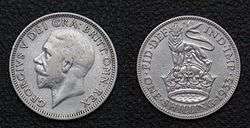

Currently the shilling is used as a currency in four east African countries: Kenya, Tanzania, Uganda and Somalia. The East African Community additionally plans to introduce an East African shilling.
History
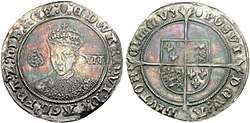
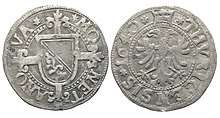
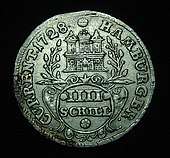
The word shilling comes from old English "Scilling", a monetary term meaning twentieth of a pound, from the Proto-Germanic root skiljaną meaning 'to separate, split, divide', from (s)kelH- meaning 'to cut, split.' The word "Scilling" is mentioned in the earliest recorded Germanic law codes, those of Æthelberht of Kent.
Recently, it has been proposed that it may represent an early borrowing of Phoenician Shekel, Punic Sql (sə'kel) meaning 'weigh' and 'coin'. The two meanings given in the literature in both Germanic and Semitic word are the same for both a fixed weight and a certain coin; the best etymology for a coin in a language of a people not familiar with currency being a reconstruction as a loanword from the language of a culturally more advanced people in contact with the people under study.[1][2][3]
In origin, the word shilling designated the solidus of Late Antiquity, the gold coin that replaced the aureus in the 4th century. The Anglo-Saxon scillingas of the 7th century were still small gold coins.
In 796, Charlemagne passed a monetary reform, based on the Carolingian silver pound (about 406.5 grams). The shilling was one twentieth of a pound, or about 20.3 grams of silver. One shilling had 12 denarii or pennies. There were, however, no silver shilling coins in the Carolingian period, and gold shillings (equivalent to twelve silver pennies) were very rare.
In the 12th century, larger silver coins of multiple penny weight were minted, known as denarii grossi or groat. These heavier coins were valued at between 4 and 20 of the silver denarii. In the late medieval period, states of the Holy Roman Empire began minting similar silver coins of multiple penny weight, some of them denominated as shilling.
In the 16th century, numerous different types of "shilling" were minted in Europe. The English shilling was the continuation of the testoon coin under Edward VI, from 1551 minted in 92.5% "sterling" silver.
By the 17th century, further devaluation resulted in shillings in the Holy Roman Empire, with 48 shillings to one Reichsthaler, to no longer being struck in silver but in billon. The English (later British) shilling continued to be minted as a silver coin until 1947.
British Isles
Kingdom of England
A shilling was a coin used in England from the reign of Henry VII[4] (or Edward VI around 1550). The shilling continued in use after the Acts of Union of 1707 created a new United Kingdom from the Kingdoms of England and Scotland, and under Article 16 of the Articles of Union, a common currency for the new United Kingdom was created.
Kingdom of Scotland
The term shilling (Scots: schilling) was in use in Scotland from early medieval times.
Great Britain and the UK
Slang terms for the old shilling coins include "bob" and "hog". While the derivation of "bob" is uncertain, John Camden Hotten in his 1864 Slang Dictionary says the original version was "bobstick" and speculates that it may be connected with Sir Robert Walpole.[5]
One abbreviation for shilling is s (for solidus, see £sd). Often it was represented by a solidus symbol ("/"), which may have originally stood for a long s or ſ,[6] thus 1/9 would be one shilling and ninepence (and equivalent to 21d; the shilling itself was equal to 12d). A price with no pence was sometimes written with a solidus and a dash: 11/–.
During the Great Recoinage of 1816, the mint was instructed to coin one troy pound (weighing 5760 grains or 373 g) of standard (0.925 fine) silver into 66 shillings, or its equivalent in other denominations. This set the weight of the shilling, and its subsequent decimal replacement 5 new pence coin, at 87.2727 grains or 5.655 grams from 1816 until 1990, when a new smaller 5p coin was introduced.
The common currency created in 1707 by Article 16 of the Articles of Union continued in use until decimalisation in 1971. In the traditional pounds, shillings and pence system, there were 20 shillings per pound and 12 pence per shilling, and thus there were 240 pence in a pound.
Three coins denominated in multiple shillings were also in circulation at this time. They were:
- the florin, two shillings (2/–), which adopted the value of 10 new pence (10p) at decimalisation;
- the half-crown, two shillings and sixpence (2/6) or one-eighth of a pound, which was abolished at decimalisation (otherwise it would have had the value of 121⁄2p);
- the crown (five shillings), the highest denominated non-bullion UK coin in circulation at decimalisation (in practice, crowns were commemorative coins not used in everyday transactions).
At decimalisation in 1971, the shilling coin was superseded by the new five-pence piece, which initially was of identical size and weight and had the same value, and inherited the shilling's slang name of a bob. Shillings remained in circulation until the five pence coin was reduced in size in 1991.
Irish shillings
Between 1701 and the unification of the currencies in 1825, the Irish shilling was valued at 13 pence and known as the "black hog", as opposed to the 12-pence English shillings which were known as "white hogs".
In the Irish Free State and Republic of Ireland the shilling coin was issued as scilling in Irish. It was worth 1/20th of an Irish pound, and was interchangeable at the same value to the British coin, which continued to be used in Northern Ireland. The coin featured a bull on the reverse side. The first minting, from 1928 until 1941, contained 75% silver, more than the equivalent British coin. The original Irish shilling coin (retained after decimalisation) was withdrawn from circulation on 1 January 1993, when a smaller five pence coin was introduced.
British Empire
Australian shillings
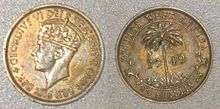
Australian shillings, twenty of which made up one Australian pound, were first issued in 1910, with the Australian coat of arms on the reverse and King Edward VII on the face. The coat of arms design was retained through the reign of King George V until a new ram's head design was introduced for the coins of King George VI. This design continued until the last year of issue in 1963. In 1966, Australia's currency was decimalised and the shilling was replaced by a ten cent coin (Australian), where 10 shillings made up one Australian dollar.
The slang term for a shilling coin in Australia was "deener". The slang term for a shilling as currency unit was "bob", the same as in the United Kingdom.
After 1966, shillings continued to circulate, as they were replaced by 10-cent coins of the same size and weight.
New Zealand shilling
New Zealand shillings, twenty of which made up one New Zealand pound, were first issued in 1933 and featured the image of a Maori warrior carrying a taiaha "in a warlike attitude" on the reverse.[7] In 1967, New Zealand's currency was decimalised and the shilling was replaced by a ten cent coin of the same size and weight. Ten cent coins minted through the remainder of the 1960s included the legend "ONE SHILLING" on the reverse. Smaller 10-cent coins were introduced in 2006.
Maltese shillings
The shilling (Maltese: xelin, pl. xelini) was used in Malta, prior to decimalisation in 1972, and had a face value of five Maltese cents.
Ceylonese shillings
In British Ceylon, an shilling (Sinhala: Silima, Tamil: Silin) was equivalent to eight fanams. With the replacement of the rixdollar by the rupee in 1852, a shilling was deemed to be equivalent to half a rupee. On the decimalisation of the currency in 1869, a shilling was deemed to be equivalent to 50 Ceylon cents. The term continued to be used colloquially until the late 20th century.[8]
East African shillings
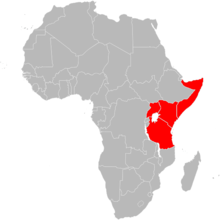
The East African shilling was in use in the British colonies and protectorates of British Somaliland, Kenya, Tanganyika, Uganda and Zanzibar from 1920, when it replaced the rupee, until after those countries became independent, and in Tanzania after that country was formed by the merger of Tanganyika and Zanzibar in 1964. Upon independence in 1960, the East African shilling in the State of Somaliland (former British Somaliland) and the Somali somalo in the Trust Territory of Somalia (former Italian Somaliland) were replaced by the Somali shilling.[9]
In 1966, the East African Monetary Union broke up, and the member countries replaced their currencies with the Kenyan shilling, the Ugandan shilling and the Tanzanian shilling, respectively.[10] Though all these currencies have different values at present, there were plans to reintroduce the East African shilling as a new common currency by 2009,[11] although this has not come about.
North America
In the thirteen British colonies that became the United States in 1776, British money was often in circulation. Each colony issued its own paper money, with pounds, shillings, and pence used as the standard units of account. Some coins were minted in the colonies, such as the 1652 pine-tree shilling in the Massachusetts Bay Colony. After the United States adopted the dollar as its unit of currency and accepted the gold standard, one British shilling was worth 24 US cents. Due to ongoing shortages of US coins in some regions, shillings continued to circulate well into the nineteenth century. Shillings are described as the standard monetary unit throughout the autobiography of Solomon Northup (1853)[12] and mentioned several times in the Horatio Alger, Jr. story Ragged Dick (1868).[13][14]
Somali shilling
The Somali shilling is the official currency of Somalia. It is subdivided into 100 cents (English), senti (Somali, also سنت) or centesimi (Italian).
The Somali shilling has been the currency of parts of Somalia since 1921, when the East African shilling was introduced to the former British Somaliland protectorate. Following independence in 1960, the somalo of Italian Somaliland and the East African shilling (which were equal in value) were replaced at par in 1962 by the Somali shilling. Names used for the denominations were cent, centesimo (plural: centesimi) and سنت (plurals: سنتيمات and سنتيما) together with shilling, scellino (plural: scellini) and شلن.
That same year, the Banca Nazionale Somala issued notes for 5, 10, 20 and 100 scellini/shillings. In 1975, the Bankiga Qaranka Soomaaliyeed (Somali National Bank) introduced notes for 5, 10, 20 and 100 shilin/shillings. These were followed in 1978 by notes of the same denominations issued by the Bankiga Dhexe Ee Soomaaliya (Central Bank of Somalia). 50 shilin/shillings notes were introduced in 1983, followed by 500 shilin/shillings in 1989 and 1000 shilin/shillings in 1990. Also in 1990 there was an attempt to reform the currency at 100 to 1, with new banknotes of 20 and 50 new shilin prepared for the redenomination.[15]
Following the breakdown in central authority that accompanied the civil war, which began in the early 1990s, the value of the Somali shilling was disrupted. The Central Bank of Somalia, the nation's monetary authority, also shut down operations. Rival producers of the local currency, including autonomous regional entities such as the Somaliland territory, subsequently emerged.
Somalia's newly established Transitional Federal Government revived the defunct Central Bank of Somalia in the late 2000s. In terms of financial management, the monetary authority is in the process of assuming the task of both formulating and implementing monetary policy.[16] Owing to a lack of confidence in the Somali shilling, the US dollar is widely accepted as a medium of exchange alongside the Somali shilling. Dollarization notwithstanding, the large issuance of the Somali shilling has increasingly fueled price hikes, especially for low value transactions. This inflationary environment, however, is expected to come to an end as soon as the Central Bank assumes full control of monetary policy and replaces the presently circulating currency introduced by the private sector.[16]
Somaliland shilling
The Somaliland shilling is the official currency of Somaliland, a self-declared republic that is internationally recognised as an autonomous region of Somalia.[17] The currency is not recognised as legal tender by the international community, and it currently has no official exchange rate. It is regulated by the Bank of Somaliland, the territory's central bank. Although the authorities in Somaliland have attempted to bar usage of the Somali shilling, Somalia's official currency is still the preferred means of exchange for many peoples in the region.[18]
Other
Elsewhere in the former British Empire, forms of the word shilling remain in informal use. In Vanuatu and Solomon Islands, selen is used in Bislama and Pijin to mean "money"; in Malaysia, syiling (pronounced like shilling) means "coin". In Egypt and Jordan the shillin (Arabic: شلن) is equal to 1/20th (five qirshes — Arabic: قرش, English: piastres) of the Egyptian pound or the Jordanian dinar. In Belize, the term shilling is commonly used to refer to twenty-five cents.
Other countries
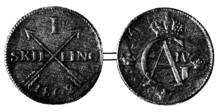
- The Austrian schilling was the currency of Austria between 1 March 1924[19] and 1938 and again between 1945 and 2002. It was replaced by the euro at a fixed parity of €1 = 13.7603 schilling. The schilling was divided into 100 groschen.
- In the principalities covering present Netherlands, Belgium and Luxemburg, the cognate term schelling was used as an equivalent 'arithmetic' currency, a 'solidus' representing 12 'denarii' or 1/20 'pound', while actual coins were rarely physical multiples of it, but still expressed in these terms.
- Shillings were issued in the Scandinavian countries (skilling) until the Scandinavian Monetary Union of 1873, and in the city of Hamburg, Germany.
- In Poland szeląg was used.[20]
- The soll, later the sou, both also derived from the Roman solidus, were the equivalent coins in France, while the (nuevo) sol (PEN) remains the currency of Peru.
- As in France, the Peruvian sol was originally named after the Roman solidus, but the name of the Peruvian currency is now much more closely linked to the Spanish word for the sun (sol). This helps explain the name of its temporary replacement, the inti, named for the Incan sun god.
References
- https://www.jstor.org/stable/j.ctvbkk16h.29?seq=1#metadata_info_tab_contents
- https://play.google.com/books/reader?id=iDG2DwAAQBAJ&hl=en_CA&pg=GBS.PP1
- https://phys.org/news/2020-07-shillings-gods-runes-clues-language.html
- "Understanding old British money - pounds, shillings and pence". woodlands-junior.kent.sch.uk. Archived from the original on 27 September 2012. Retrieved 27 April 2018.
- John Camden Hotten (1864). Slang Dictionary.
- "May and the Slash - English Project". www.englishproject.org. Archived from the original on 22 October 2017. Retrieved 27 April 2018.
- Reserve Bank of New Zealand Archived 23 January 2009 at the Wayback Machine- URL retrieved 17 April 2011
- Early Monetary Systems of Lanka (Ceylon) Archived 22 June 2011 at the Wayback Machine, Currency Museum Circular No 7, Currency Department, Central Bank of Ceylon, Colombo, 15 March 1984
- Description of Somalia shilling - URL retrieved 8 October 2006
- Dissolution of the East African Monetary Union Archived 11 March 2007 at the Wayback Machine - URL retrieved 8 October 2006
- East African Business Council - Fact Sheet: Customs Union Archived 10 March 2007 at the Wayback Machine - URL Retrieved 8 October 2002
- Solomon Northup. Twelve Years a Slave. Auburn, Derby and Miller; Buffalo, Derby, Orton and Mulligan; [etc., etc.] 1853
- Alger, Horatio, Jr (5 May 1868). Ragged Dick; or, Street Life in New York with the Boot Blacks (1 ed.). New York: A K Loring.
- Lundin, Leigh (11 May 2014). "Literary Rags". SleuthSayers.org. New York: SleuthSayers. Archived from the original on 11 August 2014.
- "CURRENCY". somalbanca.org. Archived from the original on 27 December 2016. Retrieved 27 April 2018.
- "Central Bank of Somalia - Monetary policy". somalbanca.org. Archived from the original on 25 January 2009. Retrieved 27 April 2018.
- "Somaliland's Quest for International Recognition and the HBM-SSC Factor". wardheernews.com. Archived from the original on 28 May 2012. Retrieved 27 April 2018.
- "Time for Somaliland to Rethink its Strategy". www.hiiraan.com. Archived from the original on 14 September 2017. Retrieved 27 April 2018.
- "Gold and silver shillings of Austria". Knowledge base - GoldAdvert. 14 June 2018. Retrieved 15 June 2018.
- "shillings - Polish translation – Linguee". Linguee.com. Retrieved 27 April 2018.
External links
![]()
- British Coins - Information about British coins.
- The History of the Shilling